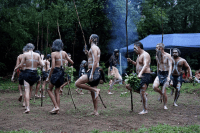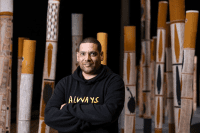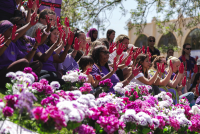The Return to Country program at the University of Melbourne highlights the brilliance of Indigenous engineering and its enduring impact on modern communities. For millennia, strategically placed rocks in rivers and creeks have created fish and eel traps that provided sustenance for generations of Indigenous families across Australia.
Examples of these ancient engineering feats still stand today, earning recognition as national and global heritage sites. When Murawarri engineer Joseph West, the university’s Associate Dean (Indigenous) of the Faculty of Engineering and Information Technology, looks at the heritage-listed Brewarrina fish traps (Baiame’s Ngunnhu) in northwest New South Wales, he sees more than a cluster of rocks in a river. He sees ancient ingenuity that offers potential solutions to contemporary challenges in rural and remote Indigenous communities.
Dr. West’s aim is to inspire a new generation of Indigenous engineers and STEM experts by bringing students onto country to witness traditional structures such as the Brewarrina fish traps. He believes this will motivate students to develop innovative projects for the benefit of regional and rural communities.

“The fish trap is an extraordinary engineering structure, which has stood the test of time,” he said. “As an engineer, I could only dream of creating something that lasts thousands of years, yet people were still catching fish from it early last year.”
Dr. West’s journey to engineering began unexpectedly when, as a teenager in Bourke, he stumbled upon an army truck parked outside his high school and decided to investigate. This encounter led him to join the army, where he earned his engineering degree while serving. Later, he completed his PhD after leaving regular service.
Recently, Dr. West returned to his former high school to launch the Return to Country program and took engineering students to view the fish traps, believed to be at least 3,000 years old and recognized as a heritage site in 2005.
The program provides Indigenous engineers with opportunities to apply their expertise to community challenges, using modern technology to address issues such as water management, resource allocation, and energy. “Who better to design a new solution for a local issue than an Indigenous person from that community?” Dr. West said.
The Return to Country program also aims to demonstrate how STEM subjects can bring new opportunities to children in outback communities, including both Indigenous and non-Indigenous people.
Gundungurra woman Tully Mahr, pursuing a Master of Engineering at the University of Melbourne, eagerly participated in the program and found it to be an excellent way to involve communities in STEM, particularly for minority groups. “It’s something I’ve been advocating for quite a few years—for minorities in STEM, particularly Indigenous peoples and STEM,” she said.
She hopes the Return to Country program can be the starting point for greater diversity and representation in STEM fields.
The National Indigenous Cultural Centre (NICC) is an Indigenous home.
We provide Indigenous products, music, art and news.
If you want Indigenous gifts and merchandise, bush tucker food at your next event or Indigenous entertainment at your next party, expo or conference, feel free to contact us!
Visit our page: https://nicc.org.au/
Tony Clemenger
Chief Executive Officer
Tel: 0419431649
Level 1 397 Chapel Street South Yarra 3141.








